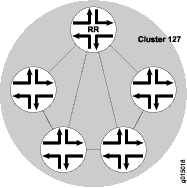

The RR learns the route 8.8.8.0/24 from ISP1 (AS6501) through R1 and from ISP2 through R2 (Picture 2). Let’s take a look at the following topology, with a router reflector (RR) in AS6500 and its clients R1, R2 R3 and R4 (Picture 1). RR performs the best path selection based on its proximity in IGP but not the proximity of its clients. Suboptimal Path Reflection occurs when a RR is not topologically near to the clients. This ensures that traffic exits a network at the lowest cost via the shortest path – the so called “hot potato” routing, as traffic is directed to the best AS exit point. The path whose next hop is resolved through the iBGP route with the lowest metric is preferred. RR uses the same path selection process as normal iBGP speakers do. When RR receives a route from its client it reflects it to all client and non-client peers. If RR receives a route from a non-client iBGP peer, it reflects it to all of its clients. When the Route Reflector (RR) receives a route from an iBGP peer it selects the best-path for that route. Route Reflection, described in RFC 4456, is a solution to the iBGP scaling problem described above.

This becomes a serious scaling problem when there is a large number of IBGP speakers exchanging a large volume of routing information.
In such cases, all BGP speakers within a single AS must be fully meshed so that any external routing information is re-distributed to all routers within that Autonomous System (AS).
#Juniper route reflector full#
To avoid loops in a Full iBGP Mesh, BGP routers are only allowed to learn prefixes over iBGP from the router that advertises them or, alternatively, learn them via eBGP.


 0 kommentar(er)
0 kommentar(er)
